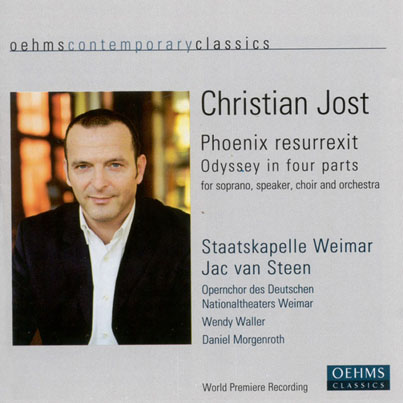Phoenix Resurrexit
VISION OF THE WORK
Odyssey in four parts Text compilation by Christian Jost and Oliver Buslau for narrator, soprano, choir and orchestra
Phoenix Resurrexit is a special work for me in many ways. Not only because the piece took around four years to complete, but also because during its creation, Phoenix Resurrexit revealed itself to be an infinite arsenal of the entire range of highs and lows of a creative process. Thus, the title became a compositional programme of recurring destruction, creation and renewal, with a single constant: nothing could have dissuaded me from writing Phoenix. Over the course of four years, the piece receded further into the distance than the constellation of Pegasus, only to become tangible again near the moon, ultimately turning out to be the fulfilment of a childhood dream.
This dream began in 1969: at the age of seven, I watched the moon landing with my mother from the comfort of our living room. When the Apollo 11 capsule splashed down in the Pacific Ocean, I made up my mind: I wanted to be an astronaut. However, family holidays to the Alps during this period, involving eight to ten hours of driving, forced me to radically rethink my plans. After all, what future astronaut could afford to spend the entire journey vomiting in a VW estate car? So I became a composer.
The virtue and curse of compositional work is that it makes the unknown and the idiosyncratic a fascinating experience. In doing so, one delves into many strange – and not always weightless – spaces, which can seem as hostile to a few listeners as space seems to astronauts. Elicit sounds from music that hold an odyssey, which the composer traces in an exciting way, is the task and concern of all my compositional work. Phoenix resurrexit has demanded the most intense engagement of my work to date.
‘…the story of creation, paired with the myth of the Phoenix bird and experienced through the eyes of an astronaut…’
When I first had the idea of composing a larger work that would shed new light on creation from the perspective of astronauts and through the insights gained from space travel, Oliver Buslau and I sought out appropriate texts. As I delved deeper into the subject, the wheat separated from the chaff again and again, and Phoenix resurrexit became a concentration reduced to its most essential elements.
The soprano was thus given the unambiguous role of the phoenix, that constantly renewing mythical bird creature. Its repetitive words appear in a wide variety of places throughout the plot. It thus becomes a metaphorical symbol, embodying at the same moment: mythical exoticism and love, the beginning of the discovery of infinity and the looming certainty of the apocalypse.
Following the original idea of creation, this permanently occurring state of simultaneous creation and destruction of life, I have created a corresponding plot, which I have called an odyssey in four parts. The narrator’s task is to internalise and illustrate this four-part odyssey.
Despite the complexity of the subject matter and the musical structures used, the common thread, the overarching dramaturgy of the whole, is a kind of large-scale symphonic form consisting of an exposition, an adagio, a scherzo and an apotheotic finale. Here, the respective musical building blocks from which the entire network is woven resound in ever-changing dramaturgical moments, are placed in constantly changing contexts, illuminate the same idea in a different context and lend a different interpretation to what has been said.
Two further works were composed in the context of Phoenix resurrexit, whose musical material influenced Phoenix and, following their own dynamics, developed it further:
Rhapsody No. II – The Song of the Phoenix for violin and piano
Sinfonia – The Dream of the Phoenix for orchestra
The connecting element of all three works is not diverse sounds and tones, but the fascination of creation and its simultaneous destruction and renewal.
Christian Jost
The text is based on quotes from various interviews and travel reports by the following astronauts and cosmonauts: John Glenn Jr. (USA) – Aleksandr Volkov (USSR) – Dumitru Prunariu (Romania) – James Irving (USA) – Valery Ryumin (USSR) – Shugderdemydin Gurragtschaa (Mongolia) – Robert Gibson (USA) – Svetlana Savitskaya (USSR) – Anatoly Berezovoy (USSR) – Neil Armstrong (USA), Apollo 11, moon landing 1969 – Gagarin (USSR) aboard Vostok 1, 1961.
Also:
The Bible – Creation story of Polynesia – Egyptian Book of the Dead, Phoenix myth – Ovid, Metamorphoses – Hildegard von Bingen, Mythical texts of the divine order – Conrad Ferdinand Meyer, Flight of the Seagulls – Joseph Conrad, Heart of Darkness – Richard Rhodes, Trinity or The Monday that changed the world – Victor Segalen, Sound Stone
THE WORK IN THE MEDIA

for soprano, speaker, choir and orchestra
with Staatskapelle Weimar, Opernchor des Deutschen Nationaltheaters Weimar, Wendy Waller and Daniel Morgenroth conducted by Jac van Steen